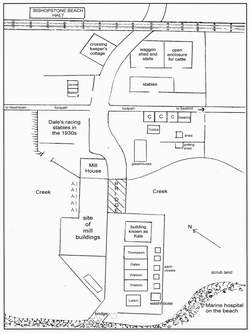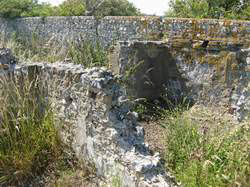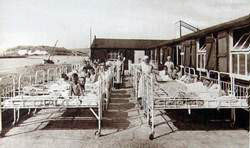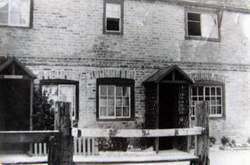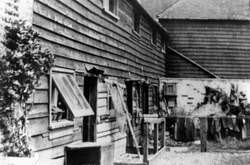Abandoned Communities ..... Tide Mills
Although the mill disappeared the village continued to be occupied until 1940. Today it is difficult to pick out the remains of dwellings among the ruins that still exist. The only house that can be clearly identified is Station House, occupied by the stationmaster, at the northern end of the village near the railway line. There is a good information board with diagrams of the layout of the house and an explanation of the two main building phases. At the southern end of the village there was a row of houses, numbers 8 to 13. They faced the mill across Mill Drove, the main road through the village. People living in these houses were particularly proud of the lattice porches outside their front doors. Another row of houses lay close to the public footpath that runs between Newhaven and Seaford, and there were about three other houses scattered around the village.
At the time of the census in 1911 15 households were recorded at Tide Mills, with a total population of 75. The Colgate family, including an elderly aunt Catherine Bell, lived at Mill House. Frederick Bone lived at Station House with his wife Rachel and their four year old daughter Winifred. They had a lodger, Eliza Greenin, a widow of 83. The largest household was the Davis family at no. 9. Edward Davis, a fish dealer, lived there with his wife Annie and their seven children, including Arthur and Hilda, whom we shall hear more about in a moment. The smallest household was at no.11, where James Larkin, a cowman, lived alone. The only female head of household was Charlotte Watson at no. 12, who lived with her son Frank, a farm worker aged 17, and daughter Winifred, aged 14 but without occupation.
The occupations of the men recorded in that census include several dock labourers and crane drivers, presumably employed at Newhaven. John Geering, aged 69, at Meadow Cottage was a ship keeper, and two other men were seamen. Others were employed in agriculture or gardening. John Geering's grandson, Reginald Clift, aged 16, was an outfitter's assistant. For most of the women no occupation is given, but a few worked as domestic servants or charwomen.
During the First World War a seaplane base was established close to Tide Mills, with two hangars at the top of the shingle beach. Officers were accommodated at Mill House, and for other staff temporary buildings were erected on stilts above the shingle. After the war these buildings continued to be used as holiday accommodation, and were supplemented by a number of railway carriages.
According to Hilda Davis, later Hilda Baker, two crashes occurred close to the seaplane base. On the first occasion a seaplane failed to clear a breakwater. As it hit the breakwater if burst into flames, and the two officers in it were killed. Hilda herself and one of her brothers were present to witness the second accident, when a plane hit a spire above one of the cottages and fell into the area where the mill had been. Its pilot was killed. A watching naval officer warned Hilda and her brother that it carried an unexploded bomb. They hurried to lie flat on the beach, but the bomb went into the mud and did not explode.
Early in the 1920s part of the village was taken over by David Dale for use as stables. The stables specialised in the care of sick and disabled racehorses. The horses were exercised along the beach and in the shallow water at the edge of the sea.
In 1924 a hospital and school for boys was built on the shingle close to the village. It was run by Chailey Heritage and provided accommodation for about a hundred boys in the belief that sea air would be good for their health. Later a home for nursing staff was built nearby. The footings of the hospital and the nurses' home can still be clearly seen.
At the time of the census in 1911 15 households were recorded at Tide Mills, with a total population of 75. The Colgate family, including an elderly aunt Catherine Bell, lived at Mill House. Frederick Bone lived at Station House with his wife Rachel and their four year old daughter Winifred. They had a lodger, Eliza Greenin, a widow of 83. The largest household was the Davis family at no. 9. Edward Davis, a fish dealer, lived there with his wife Annie and their seven children, including Arthur and Hilda, whom we shall hear more about in a moment. The smallest household was at no.11, where James Larkin, a cowman, lived alone. The only female head of household was Charlotte Watson at no. 12, who lived with her son Frank, a farm worker aged 17, and daughter Winifred, aged 14 but without occupation.
The occupations of the men recorded in that census include several dock labourers and crane drivers, presumably employed at Newhaven. John Geering, aged 69, at Meadow Cottage was a ship keeper, and two other men were seamen. Others were employed in agriculture or gardening. John Geering's grandson, Reginald Clift, aged 16, was an outfitter's assistant. For most of the women no occupation is given, but a few worked as domestic servants or charwomen.
During the First World War a seaplane base was established close to Tide Mills, with two hangars at the top of the shingle beach. Officers were accommodated at Mill House, and for other staff temporary buildings were erected on stilts above the shingle. After the war these buildings continued to be used as holiday accommodation, and were supplemented by a number of railway carriages.
According to Hilda Davis, later Hilda Baker, two crashes occurred close to the seaplane base. On the first occasion a seaplane failed to clear a breakwater. As it hit the breakwater if burst into flames, and the two officers in it were killed. Hilda herself and one of her brothers were present to witness the second accident, when a plane hit a spire above one of the cottages and fell into the area where the mill had been. Its pilot was killed. A watching naval officer warned Hilda and her brother that it carried an unexploded bomb. They hurried to lie flat on the beach, but the bomb went into the mud and did not explode.
Early in the 1920s part of the village was taken over by David Dale for use as stables. The stables specialised in the care of sick and disabled racehorses. The horses were exercised along the beach and in the shallow water at the edge of the sea.
In 1924 a hospital and school for boys was built on the shingle close to the village. It was run by Chailey Heritage and provided accommodation for about a hundred boys in the belief that sea air would be good for their health. Later a home for nursing staff was built nearby. The footings of the hospital and the nurses' home can still be clearly seen.
Three
Plan of Tide Mills village, taken from David Lyndhurst’s book, Bishopstone and the Lost Village of Tide Mills. Names in several of the houses are the surnames of families who lived there in the 1920s and 1930s.
Part of Station House
The solarium at the Chailey Heritage Hospital.
This photo comes from a souvenir letter card seen at Newhaven Museum.
The front and back of two houses at Tide Mills. I think they are number 9 and 10. In the back garden you can see a shrimp net leaning against the wall and a meat safe on the wall in the background.
